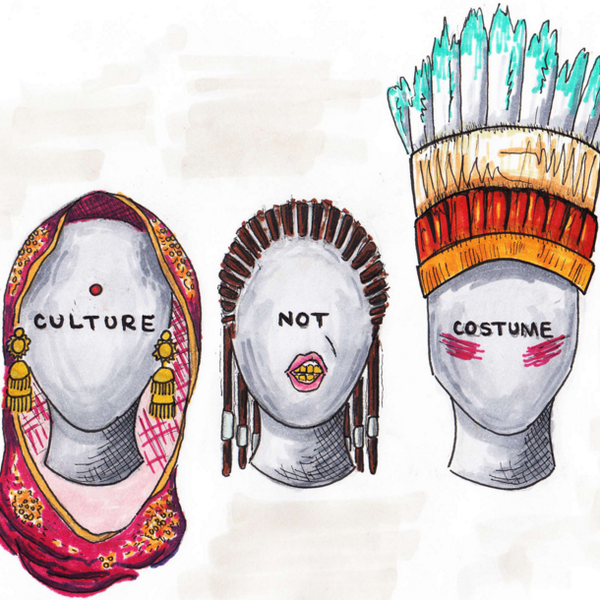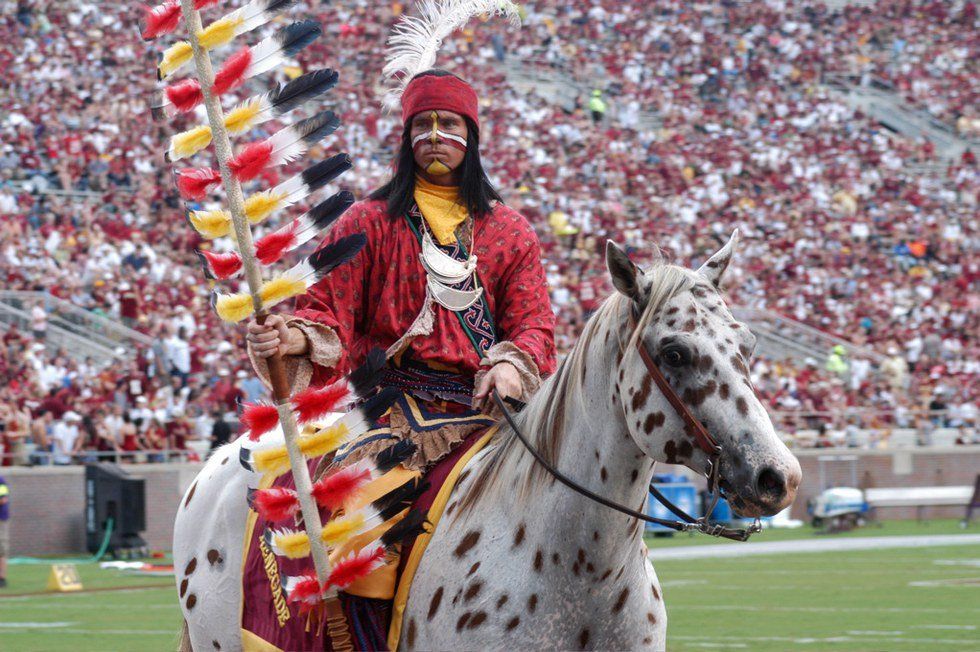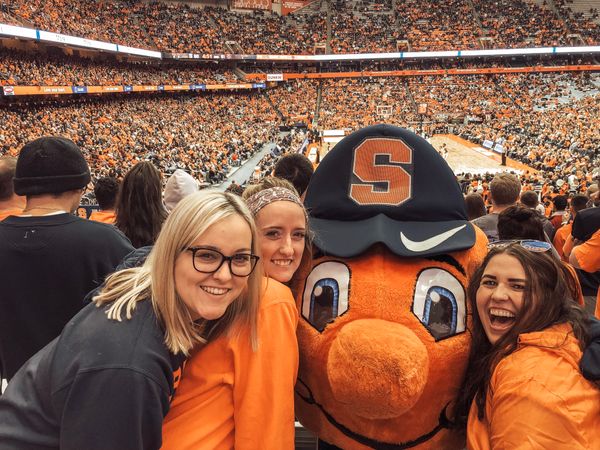In the era where racism and bigotry was widely accepted by dominant American culture, “Indian” mascots grew to become multi-million dollar franchises. However, this intolerance and harm promoted by these “Indian” sports brands have had very real consequences for First Nation citizens.
The NCAI launched a campaign to address stereotypes of First Nation people in popular culture, media, and sports. However, the pursuit of racial equality among Native people began well before the NCAI established this campaign to end negative and harmful stereotypes in sports. Over the last fifty years, a dramatic rise of support has teamed up to end the era of racist and harmful “Indian” mascots in sports. And today, that support is stronger than ever before. Since this effort began, significant progress has been made at the professional, collegiate, and high school levels to change the once accepted race-based marketing practices.
This is not an issue of being politically correct
This is not an issue about “being offended”. This perspective often comes from people of privilege that are unable to comprehend what racial oppression is, and what it actually feels like to experience and suffer from it. This perspective attempts to dismiss this issue by insisting that portraying these negative stereotypes is victimless, and merely an issue of political correctness about holding opposing views on the issue. However, the reality of the situation is that the usage of these “Indian” images, despite the repeated objections of the First Nation community, causes serious risk and negative consequences for this community.
If a cultural community is telling you it is wrong, you don’t get to say no
You do not get to tell this community that they are being too sensitive, or taking the situation too personally. The people who have privilege do not get to decide what should or should not offend First Nation citizens. This issue is based on the problem of who has the power to decide how marginalized groups are represented. You cannot say that “Indian” mascots aren’t racist because you personally aren’t offended. That is your privilege. The fact of the matter is hundreds of tribal nations, national and regional tribal organizations, civil rights organizations, and individuals have pleaded for the end to harmful “Indian” mascots. First nation individuals have their own sports teams, and yet you won’t see them in a feathered headdress covered in war paint. You won’t see them chanting a fake war song or portraying the tomahawk chop, because real “Indians” don’t do that. So why should white people have the right to portray those actions?
We are NOT honoring them
There is nothing about the sports team names, mascots, or imagery that honor First Nation people. Mascots and fans dressing up like “Indians” and performing the tomahawk chop is insulting and highly offensive, not honorable. People participating in these activities probably think “Indians are so cool”, and that’s part of the problem on why people think these activities are honorable. People think they truly like “Indians” when participating in these actions, but instead they are actually paying tribute to these stereotypes of First Nation people that has been perpetuated by mainstream American propaganda for centuries. Anyone who has spent time with real First Nation people would not be painting their face red and donning feathers on their head as an imitation of these fake “Indians”. This “honor” is a result of systemic, cultural, institutionalized racism.
‘Honor’ assumes that the receiving party feels something positive, such as pride, at the association, not to mention it implies respect for something and the harassment and bullying towards anti-mascot protesters has clearly demonstrated that their voices are not respected. First Nation people do not feel any admiration at this association. And if this community tells you it is not an honor, then it is NOT an honor! If you feel so strongly about honoring First Nations people than spend time with these people and listen to their stories and who they really are. Maybe then you’ll understand why “Indian” mascots are so offensive.
It is not a tradition
This “tradition” has only existed for about 100 years, that is not anywhere near long enough to be justifiable. First Nations people have traditions that are thousands of years old. White Americans have traditions that are thousands of years old. And these traditions do not resemble the stereotyped, satirized images associated with “Indian” mascots and team names. Things change, and retiring racist mascots would be a change for the better.
“Indian” mascots began in the 1900s, following the end of the Indian wars. At this time Native Americans were considered the “vanishing race.” The Native American culture and artifacts was highly popularized, and selling like crazy – all in the hopes of obtaining some memento before they all disappeared. This is when “Indian” images and characters were created and marketed and mass produced. This is when First Nations began to be memorialized and mythologized. So of course schools and sports teams would choose these mascots of brave impassive savages from the past. These “traditional” mascots honor the idea of passive, silent, defeated, and non-existent Indians, not the true living, breathing, fighting Native Americans. Honoring these “traditional Indians” invalidates who they are today, and their protests against these racist mascots damages the stoic “Indian” image Americans have become so accustomed to.
It promotes negative stereotypes
Rather than honoring First Nation people, these harmful portrayals are perpetuating negative stereotypes, and contributing to dehumanizing this community. First Nation people are the only racial group in the United States that are exposed to having racial slurs and images as a brand of a sports team. These images are contributing to prejudice and discrimination against First Nations people. This behavior exposes Native Americans to a harmful stereotype and condones the use of racist against by non-Native Americans – these same actions which would be seen as harassment or bullying if performed on an individual personal level. These negative “Indian” stereotypes affect the reputation and self-image of every single Native American, and nurtures ongoing discrimination against this community. “Indian” mascots and stereotypes present a misrepresentative image of Native Americans, and perpetuates the historic myths that have been used to whitewash a history of oppression.
It dehumanizes First Nation people.
“Indian” mascots belittle Native Americans as people. The portrayal of Native Americans as soul-less, war hungry savages has worked for years to justify the genocide of these people for the “progress of civilization”. Today, the “Indian” mascot still aids in suppressing and belittling Native Americans and reducing them to second-class mythological citizens. This makes it so that Native Americans are not taken seriously, and their voices not included in national issues. When political representatives are talking about race, Native Americans are rarely mentioned. When conversations about racial diversity take place Native American are usually not even considered. This is how “Indian” mascots harm them because Americans would rather have their mascot. SOMEONE is a human being, and SOMETHING is a mascot, and yet sports industries have placed Native Americans in the latter category. We have made this community invisible and silent, insulted their ethnicity and culture, and belittled their character.
Using “Indian” mascots and brands dehumanized this race because it places them into an entertainment category, a category no other ethnic community endures today. And once a race is dehumanized and caricatured it is easy to ignore the struggles and perspectives this community faces. It creates a one-dimensional view of First Nations people, reducing them to violent, aggressive, savages that can be mocked, ridiculed and violated by fans of opposing teams. Or they’re reduced to some mythological creature, rather than a human race.
It has serious negative impacts on First Nations people.
There are harmful effects associated with the continual “tradition” of Native American mascots for sports teams. Decades of social science research has documented that derogatory “Indian” sports mascots have serious psychological, social, and cultural consequences for Native Americans, specifically Native American children, and affect their overall well-being. This is because of the stress experienced from ongoing discrimination from racial slurs, racial harassment, and bullying. First Nation people exhibit the highest level of psychological distress than any other group in the United States. This includes the highest levels of depression, substance abuse, and post-traumatic stress disorder, and increased physical pain and maladaptive health behaviors. The Native American suicide rate is among the highest in the country, and has dramatically increased by 65 percent in the last decade alone.
Research has demonstrated that Native American mascots directly lowers self-esteem and lowers mood in Native American youth. Those under the age of 18 within the Native American population make up 32 percent of the entire population, and Youth under the age of 24 represent almost 50 percent of the population. These racist images are hurting these youth, an important portion of the Native American population, and therefore are intolerable. Derogatory mascots cause Native American children to feel embarrassed and ashamed of their culture, and therefore need to stop being acceptable.
These negative effects occur regardless of whether or not Native American mascots are considered "offensive". Given the significant challenges already faced by the Native American community in relation to their mental and physical well-being, sports teams need to stop participating in using racial images, mascots, brands, and slurs.
It promotes violence against First Nations people.
The most alarming result of these negative stereotypes of Native Americans is the alarmingly high rates of hate crimes against Native Americans. According to the Department of Justice analysis:
- Native Americans are more likely than people of any other race to experience violence at the hands of someone of a different race - at least 70 percent of the violent victimizations experienced by Native Americans are committed by persons, not of the same race, which is a substantially higher rate of interracial violence than experienced by white or black victims.
- Native Americans experience rates of violence that are more than twice those of the U.S. resident population.
- Rates of violence in every age group are higher among Native Americans than that of all races.
- Nearly a third of all Native American victims of violence are between ages 18 and 24. This group of Native Americans experienced the highest per capita rate of violence of any racial group considered by age & experienced about one violent crime for every four persons of this age.
“Indian” mascots are destructive because it perpetuates the stereotypical portrayal of Native Americans, and promotes and justifies the racist slurs and action – thus increasing the risk for discriminatory experiences against Native Americans.
Bottom Line: It IS racist!
The use of “Indian” mascots are disrespectful and hurtful to First Nations people. The names, images, and behaviors seen at games are nothing less than racist. This isn’t about being offended. This is about racism and ending racism in sports. There is no excuse for cultural stereotypes that degrade, slander, mock or belittle Native people. When an action causes additional stress, increased suffering, loss of productivity, loss of functioning, or further loss of life among a cultural population, and it IS preventable, this should be seen as a national priority. These factors together indicate a serious need to take immediate action, including the removal of harmful images in sports teams.
------------------------------------------------------------------------------------------------------------
References:
http://www.changethemascot.org/wp-content/uploads/2013/10/DrFriedmanReport.pdf
http://www.bjs.gov/content/pub/pdf/aic.pdf
http://www.ncai.org/policy-issues/community-and-culture/anti-defamation-mascots





















